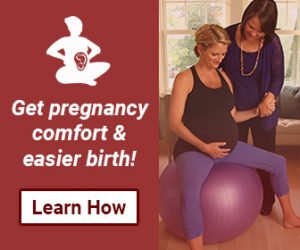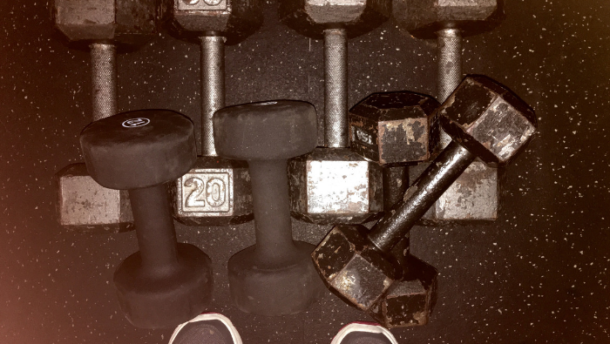Part 3 – Third Trimester Exercise Guidelines

A Little About Me
I am currently studying for my pre & post natal certification through an amazing company called Girls Gone Strong. My goal is to share as much as I can with my audience and help educate other moms (like myself) who need some guidance. I’m excited to share the last part of this three part blog series that will highlight the third trimester and some general considerations when exercising. If you are newly pregnant and haven’t read part one (guidelines in the first trimester), please refer to this blog post. Let’s get to it!
The 3rd Trimester
The third trimester is a time of rapid growth and you may be starting to feel physically uncomfortable (I know I am!). A lot of women experience aches and pains throughout the day, have a hard time getting comfortable enough to sleep, experience braxton-hicks contractions, lower back pain, pelvic girdle pain, and overall fatigue. As I write this, I am currently in my third trimester with my second baby and am experiencing all of these! Lucky me, right?! Difficulty sleeping has been the hardest one for me, I’m trying to get as much rest as I can but between insomnia and overall discomfort, it’s tough. I’m also being kicked and punched A LOT all day and night thanks to the one man party going on in my belly! I think this one is going to be a bit wild so wish me luck. #twoboylife Our bodies are working so hard right now so be easy on yourself and rest when you can (hopefully better than me!). The baby is growing at a very fast rate and we are gaining more weight as he or she grows, which can put extra strain on our bodies. This makes our workouts feel a lot more challenging! It’s a very crucial time to listen to your body and do what makes you feel best. As with the first two trimesters, your workout program will depend on your level of experience prior to pregnancy, how you feel throughout your pregnancy, and your goals. Most importantly, you will need to listen and work with your doctor to make sure you are cleared to workout and you are exercising within their guidelines and restrictions, if any. The below guidelines are not to substitute for medical advice but to share general guidelines from what I am learning and what the current research says. Please talk with your doctor before starting any workout program.

The Core & Pelvic Floor Connection
It’s still important to continue connecting your core & pelvic floor in this trimester. It’s beneficial for proper function of the pelvic floor during pregnancy, birth, and postpartum if you learn to strengthen and relax these muscles. As your belly grows, breathing may feel more challenging but it will still benefit you greatly by continuing to incorporate the connection breath (especially when it comes to preventing incontinence). Please see my previous blog post for details on what the connection breath is and how to perform it. In this trimester, I would recommend performing it seated instead of on your back, like in this video. Incorporate the connection breath either before or after your workout, whichever you prefer. I usually perform 10 breaths in my warm-up and then 10 after my workout to wind down and relax. I also like taking a few deep breaths when I get in bed every night to try and relax and wind down from the day.
Using your breath during exercise is very helpful! It’s important to avoid holding your breath or bracing too hard during movements that are more challenging. Remind yourself to breath throughout each exercise, ideally inhaling when setting up the exercise and exhaling during the effort. For example, during a squat, inhale on the way down to relax your belly and pelvic floor and then exhale on the way up as you lift the pelvic floor.
A great resource to learn more about proper breathing during exercise is this article published by Girls Gone Strong. I highly recommend reading it and watching the short video to learn more.
Relaxing your Pelvic Floor
Relaxation of the pelvic floor muscles during this trimester is also really important. During labor, you will want these muscles to relax so the baby can move down through the birth canal. Along with breathing exercises, there are a lot of really great stretches you can do daily to benefit your pelvic floor, help relieve aches & pains, and help put the baby in optimal position. Spinning Babies is an amazing resource for pregnancy and their “Daily Essentials” digital download has been SO incredibly helpful for me throughout this trimester. They offer a 35 minute stretch routine and a 28 minute prenatal yoga routine along with some tips on how to move and rest better during pregnancy. Since my first pregnancy, my lower back pain has been unreal! Doing these stretches and prenatal yoga 4-5 times a week has helped me SO much. I highly recommend purchasing (only $17) this download and taking the time to stretch, breath, and relax as much as you can. It’s so worth it! I am trying to give my baby as much room as possible to get into a head down position so I can prepare for my upcoming VBAC! Click the picture below for the link to the Daily Essentials video.
Focus and Goals
The main goals during the 3rd trimester are to:
- Maintain a comfortable level of activity (without overdoing it)
- Reduce discomfort due to our growing bellies
- Incorporate birth-preparation exercises (like the Spinning Babies downloadLINK mentioned above)
- Minimize bulging or “doming” of the abdomen (explained in more detail below)
- Minimize pressure on the pelvic floor
Strength Training
There are some modifications and changes to be made when strength training in this trimester. Like I mentioned earlier, our babies and bodies are changing at a rapid rate so we should adjust our workouts to better serve us by taking the following into consideration:
- Making sure we don’t hold our breath while lifting weights. This can cause a rise in blood pressure and lead to pelvic floor dysfunction.
- Monitoring exercises that require more effort from your abdomen. You don’t want to see any bulging of the midline while performing an exercise (more details below).
- Using lighter weights. Remember, your body weight is naturally increasing from your growing baby and that makes exercise more challenging so it’s OK to reduce your weight selection as you grow. I know this is hard for some of us (me included!) but this does not mean we are weaker or can’t do it, it’s simply listening to our body and adjusting during this time of change.
- Incorporating Birth Preparation Exercises (more details below)
Warm-Up
Just like in the first two trimesters, if you need to get yourself in the mood and ready for a sweat, including a short cardiovascular warm-up before a workout is good. BUT keep in mind it may not take much to get your heart rate up and warm your body since the weight on the pelvic floor is increasing & you are growing in size. A dynamic warm-up (examples below) may be enough. If you want to incorporate a short cardio warm-up, stick with lower impact exercises. Two to four minutes of walking, marching in place, low impact jumping jacks (stepping legs out instead of jumping), etc. is perfect.
Dynamic Warm-up exercise examples:
When creating your strength workout, here are a few examples of good exercises to do in this trimester for the major muscle groups :
- Upper Body:
- Standing Band Row
- Dumbbell Lateral Raise
- One-Arm Split-Stance Row
- Cable Tricep Extension
- Dumbbell Bicep Curl
- Alternating Dumbbell Bicep Curl
- Incline Dumbbell Bench Press OR Single-Arm Incline Dumbbell Bench Press, as shown in the video
- Glutes & Hips. Working that backside helps to keep the spine in a more neutral position (that growing belly wants to pull you forward), reduce irritation on your SI joints, and reduce unnecessary stress on your pelvic floor. Some glute exercises include:
- Legs. We need strong legs to hold up our growing bellies! For all of these exercises you have the OPTION to add weight but you don’t have to. This all depends on your current fitness level, think of the bodyweight version of the exercises as Level 1 and the weighted version as Level 2. You determine your level and get your sweat on. 🙂
Effort, Sets, and Reps
Your workouts in this trimester may look and feel differently than in the first two trimesters and that is OK. We are already Superwoman just by growing a little human! Modify by going lighter with your weights and sticking with a higher rep range if you can (2-3 sets of 12-15). You don’t want to overexert yourself, cause poor form, or hold your breath due to lifting a heavy load. While exercising, make sure you aren’t experiencing any pain, heaviness in your pelvis, or leaking of urine. Also, you never want to get to the point where you can’t speak or feel completely exhausted. Again, our goal is to build and maintain strength, not to win the crossfit games!
A few additional considerations at this point in pregnancy are…
Diastasis Recti
Diastasis Recti happens when the abdominal walls separate creating a gap in your midline. All pregnant women develop this naturally in the third trimester and for some it goes away and heals postpartum while others continue to have a wide gap for weeks or months after giving birth. There is no clear way to tell who is most likely to develop a wide gap and unfortunately there aren’t any clear answers on how to avoid it.
From what I’m learning, one thing you can do is avoid any exercises during pregnancy that cause the abdominal wall to bulge along the midline (the linea alba). We don’t want to put any extra pressure or load on the already growing abdomen. You have probably already started to notice some exercises that cause bulging (or a doming effect) as you progressed through the second trimester (see 2nd trimester post for more details LINK) so you will want to continue feeling and looking for any signs of bulging or doming in the midline while performing an exercise. Some exercises that may cause this are planks, push-ups, and sit-ups. It’s recommended at this point to eliminate these exercises in the third trimester. Especially if you feel a bulge!
Supine Position (Laying down on your back)
At this point, it’s best to eliminate or really minimize the amount of time you spend in this position. Like I mentioned in my 2nd trimester post, there seems to be a lot of mixed recommendations and research on this topic as we learn more. Physicians have said in the past that the weight of the baby while laying on your back can press on or block a mother’s vena cava, which is the main vein that carries blood back to the heart from the lower body. It seems to be a bit confusing as to how much time spent in this position could cause this to happen so it’s best to monitor how you feel while laying down. If you experience any lightheadedness, nausea, or breathlessness when lying down, it’s best to take out those exercises completely or try modifying by laying at an incline of 15 degrees. I don’t remember feeling uncomfortable in supine position during my first pregnancy but with this one, the supine position isn’t comfortable. I get lightheaded and short of breath so I have taken out all supine exercises. Fortunately, there are other options for the exercises you may like to do. For example, if you love glute bridges but experience these symptoms, try the incline position or switch to a bodyweight hip thrust to reap the same benefits.
Incorporating Birth Preparation Exercises
As I mentioned earlier in the post, relaxing your pelvic floor muscles is really important during this trimester. The connection breath (mentioned above) will help relax them along with some visualization and birth preparation exercises. It’s a bit tricky to visualize and feel your pelvic floor muscles relax but one description that seemed to stick with me is imagining yourself on the toilet peeing since you relax your muscles and let it all go! It’s not a pretty visualization but if it helps you then that’s my goal! There are a lot of not so pretty things that accompany pregnancy, can we agree?
Moving on to the birth preparation exercises! These can help move the baby into a good position and help relieve the aches and pains that come with the third trimester. Exercises like pelvic tilts, wide child’s pose, butterflies (placing soles together), and kneeling on the floor and leaning over a stability ball are all great. As I mentioned earlier, the Spinning Babies Daily Essentials is a great way to start incorporating these exercises. For me, when I invest in something and spend the money to purchase it, I am way more likely to do it! It’s not always easy to find the time and energy to do these stretches but it is very beneficial and so worth it.
Core Exercises
The biggest concern is placing excessive pressure on your midline that causes doming or bulging in your abdomen (as stated above). By the 3rd trimester, loaded abdominal exercises such as planks, crunches, and sit-ups are not recommended since your linea alba (midline) may not be able to handle them. For me, if something could potentially have more harmful effects than benefits, I don’t see the point in doing them. The last thing I want to do is try and push past my limits and cause permanent damage to my pelvic floor. Don’t forget, these modifications are only temporary! Some alternative core exercises you can perform are:
Cardio
The physiological changes that are taking place in our bodies during this time can affect our aerobic capacity so it’s normal to feel out of breath quicker, especially in this trimester. I know I do! You want to be able to talk while exercising and not be completely out of breath. Higher-impact exercises (such as running or jumping exercises) will become less comfortable so it’s best to work at a lower intensity. At this point, it’s recommended to minimize or eliminate high-impact exercises like running, jumping rope, box jumps, or anything that can put too much pressure on your pelvic floor. Again, you don’t want to overexert yourself. For me, I felt heaviness and pressure when doing higher-impact cardio exercises around week 20 of my pregnancy so I took them out of my workouts earlier on.
As stated in part 1 of this series, steady-state, low-moderate intensity cardio is safe through pregnancy and is very beneficial. Choose something that keeps your heart rate between 120-140 beats per minute. Some options are incline treadmill walking, cycling, walking outdoors, etc. I’m a HUGE fan of walking, there is nothing like getting out for some fresh air (if you can but a treadmill works too) and doing a nice walk while listening to your favorite podcast or music. I found I needed to reduce the distance I was walking in this trimester because it made my lower back pain flare up. So it’s OK to do multiple shorter walks if that works better for you. Taking a short walk is also a great pick-me-up if you sit all day at a desk or hit that afternoon slump.
Rest and Recovery
It’s crucial to listen to your body and decide what is right for you. During your workout, I recommend taking at least 30 seconds of rest in between exercises and 90 seconds to 2 minutes in between sets. If you can fit in 2-3 strength workouts per week, that’s great. If it’s only 1 because you are just feeling exhausted and/or your aches and pains are really getting to you, that’s great too. If it’s more yoga that you need one week, than do the yoga. I’ve been incorporating way more prenatal yoga and stretching in this pregnancy and it’s really benefiting me. I LOVE a good strength workout but this pregnancy has come with a lot more physical aches/pains (add in chasing around a toddler!) so I’ve learned how to slow it down a little more.
Conclusion
I hope you find these guidelines helpful and you are able to incorporate some of the exercises into your next workout. Pregnancy can throw us in all sorts of directions so again (have I said it enough?), please listen to your body and do what feels right to you. Remember, this isn’t the time to max out on weight or push yourself to the fullest. It’s a time to take care of our bodies, build our strength, and keep our growing little baby healthy.
As always, please reach out with any questions & have fun sweating the stress!
*The key points in this post are from the amazing information I am learning in my Girls Gone Strong certification so I give them all the credit. If you are a trainer looking to specialize in pre & postnatal fitness, I highly recommend getting your certification through them!
*A quick legal disclaimer – When participating in any exercise or exercise program, there is the possibility of injury. If you engage in any of the exercises or workouts on my blog, you agree to do so at your own risk. Please see full disclaimer for more details.




Recent Comments